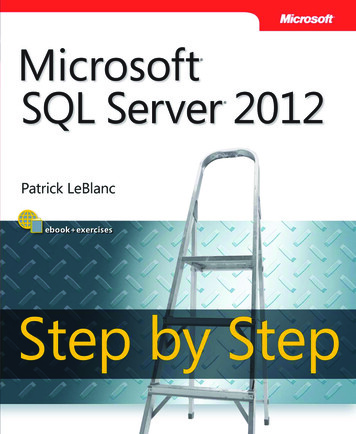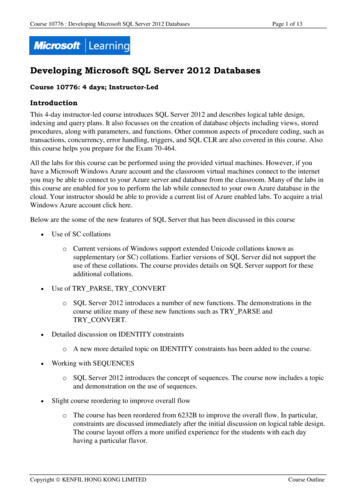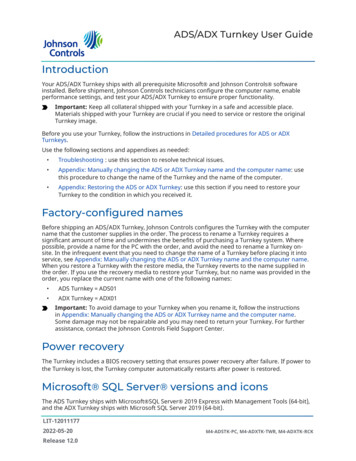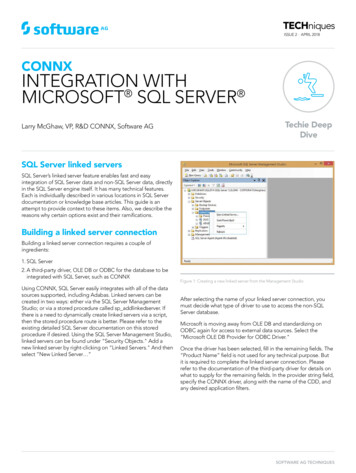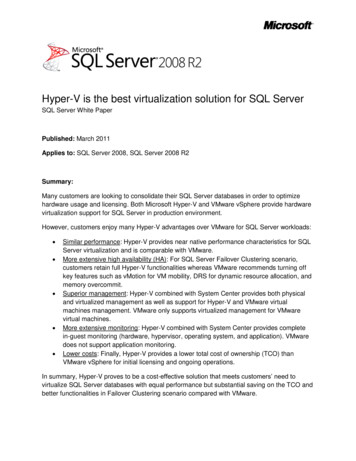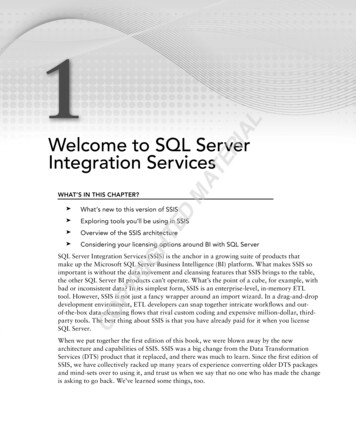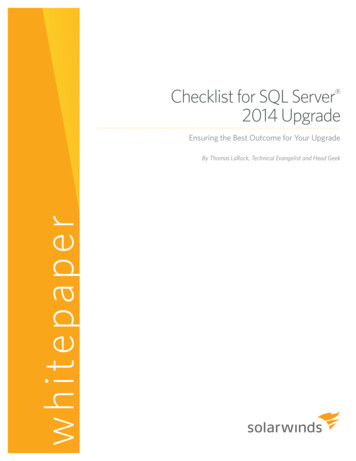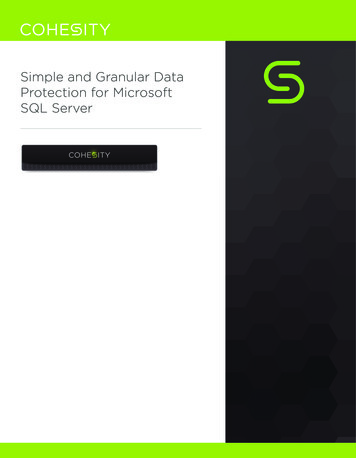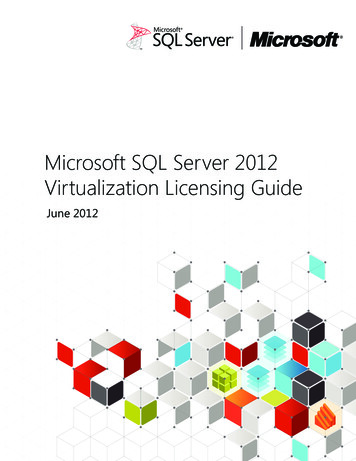
Transcription
Microsoft SQL Server 2012Virtualization Licensing GuideJune 2012
ContentsIntroduction.4Quick Overview: Licensing SQL Server 2012 for Virtualization.4Licensing Individual Virtual Machines .4Licensing for Maximum Virtualization.4Scenario 1: Server Consolidation.5Licensing Individual VMs.5Scenario 2: Dynamic Virtual Environments.8License Mobility .8Scenario 3: High Volume Dynamic Virtual Environments .10Licensing for Maximum Virtualization.10Summary.11Appendix.11SQL Server Virtualization Rights for Prior Software Releases.11 2012 Microsoft Corporation. All rights reserved.This document is for informational purposes only. MICROSOFT MAKES NO WARRANTIES, EXPRESS OR IMPLIED, IN THIS SUMMARY.Microsoft provides this material solely for informational and marketing purposes. Customers should refer to their agreements for a fullunderstanding of their rights and obligations under Microsoft’s Volume Licensing programs. Microsoft software is licensed not sold.The value and benefit gained through use of Microsoft software and services may vary by customer. Customers with questions aboutdifferences between this material and the agreements should contact their reseller or Microsoft account manager. Microsoft does notset final prices or payment terms for licenses acquired through resellers. Final prices and payment terms are determined by agreementbetween the customer and its reseller. Eligibility for Software Assurance benefits varies by offering and region and is subject to change.The Terms and Conditions of your Volume License Agreement and the Terms and Conditions under which any specific Software Assurancebenefits are offered will take precedence in the case of any conflict with the information provided here. For eligibility criteria and currentbenefit program rules, see the Microsoft Product List.2
IntroductionVirtualization is being employed in a wide range of computing scenarios today, from software developmentand testing, to disaster recovery and load balancing. To date, one of the major drivers of virtualization has beenserver consolidation. With the increase in server core density, a typical workload may use just a small fraction ofthe available computing capacity, and virtualization offers a simple way to carve out and use only the requiredprocessing power from server hardware. A key trend today is database virtualization, which allows the databaseto run in a virtual environment, enabling benefits like more efficient hardware utilization, easier management,and higher availability.To gain the benefits of database virtualization, Microsoft customers are virtualizing their SQL Server workloadsand will increasingly do so. With the release of SQL Server 2012, Microsoft introduced licensing options to helpcustomers take advantage of virtualization, and to pay in a more granular and fair way than the industry hastypically seen.In this paper, we will cover the virtualization licensing options available with SQL Server 2012 and take a closelook at the key principles involved. Along the way, we will also examine a few real-world scenarios to helpillustrate how these principles are put into practice.Quick Overview: Licensing SQL Server 2012 forVirtualizationSQL Server 2012 offers customers a unique level of flexibility when licensing in virtual environments—withoptions to license for maximum/unlimited virtualization or to carve out just the computing power needed bylicensing individual virtual machines (VMs). In this document, we will cover each of these options in detail andthe related licensing rules. First, let’s start with a brief overview of these two paths.Licensing Individual Virtual MachinesMicrosoft offers the unique option to license VMs individually. This is in contrast to other database vendorsin the industry that usually require customers to license the entire server, even when the workload utilizesonly a fraction of the available computing power. The option to license individual VMs is designed to helporganizations use hardware resources more cost-effectively by carving out and paying for just the computingpower that is needed. SQL Server can be licensed in individual VMs using the “Per Core” or the “Server CAL”licensing model. Per Core Licensing Model: Purchase a core license for each virtual core (or virtual processor/virtual CPU/virtual thread) allocated to the VM, subject to a four core license minimum per VM. Server CAL Licensing Model: SQL Server 2012 Business Intelligence and Standard Edition customerspurchase one server license for each VM running SQL Server software. In this model, each user or deviceaccessing SQL Server 2012 must also be licensed.Note that individual VMs may be licensed for SQL Server 2012 Enterprise Edition through the Server CALmodel. See page 8 for more details.Licensing for Maximum VirtualizationAs virtualized environments grow and become more dynamic, customers have the option to license formaximum virtualization, which can dramatically simplify software licensing management.3
Deploy an Unlimited Number of VMs: SQL Server 2012 Enterprise Edition customers who have licensedall of the physical cores on the server and have Software Assurance (SA) coverage may deploy any numberof VMs on that server. SQL Server 2012 Enterprise Edition customers who have licensed all the physical cores on the server butwho do not have SA coverage, can deploy a number of VMs equal to the number of core licenses assignedto the server.SQL Server 2012 EditionEnterprise(Per Core)Enterprise(Server CAL)*BusinessIntelligenceStandard(Per Core)Standard(Server CAL)Individual VMsPPPPPMaximum VirtualizationPLicensing OptionThis table summarizes the virtualization licensing options available for each SQL Server 2012 edition.* For additional information on licensing Enterprise Edition in the Server CAL licensing model, see page 8.ÂÂ For more information on these licensing options, refer to the SQL Server 2012 Licensing Guide,which can be found here:http://go.microsoft.com/fwlink/?LinkId 230678Next, we will discuss these licensing rules in more detail and walk through a few use cases to help illustrate howthese can be applied in real-world scenarios.Scenario 1: Server ConsolidationLicensing Individual VMsServer consolidation has been a major driver of virtualization in today’s IT environments. Virtualizing workloadsand consolidating them onto fewer physical servers can improve hardware utilization and reduce server hostingand administration costs.As an example, consider a manufacturing company that has a reporting workload running on a SQL Server2012 database, hosted on a dedicated server. Similarly, the company has CRM and HR applications built onSQL Server databases, and each running on their own dedicated server. After purchasing new high capacityhardware, the company decides to virtualize these three workloads and move them to a single server.Server Consolidation: Virtualizing Database WorkloadsReportingHRCRMA manufacturing company virtualizes its reporting, HR, and CRM systems and consolidates them onto a single high capacity server.4
In this scenario, the company chooses to license each VM individually. This provides the flexibility to license onlythe computing power required by each SQL Server workload. Let’s look in depth at how to license individualVMs in this example using each of the available licensing models.Licensing Individual VMs in the Per Core ModelTo license each of these VMs in the Per Core licensing model, this customer must purchase a core license foreach virtual core allocated to the VM. Consistent with Per Core licensing in the physical environment, thereis a four core minimum license requirement for each VM. (Note that for licensing purposes, a virtual core isequivalent to a virtual thread and may also be referred to as a virtual processor or virtual CPU.)To illustrate this, we’ll continue with our manufacturing company example in which three workloads have beenvirtualized and consolidated on a single server. In this example, these workloads are static and will remain onthe server.Licensing Individual VMs in the Per Core ModelReportingHRCRMNumber of core licenses required: 4VM #1 (4 core minimum)4VM #26VM #314core licenses requiredPurchase 7 “2-Pack” SKUs of core licenses(cores sold in 2-core packs)Each VM is licensed individually using the Per Core licensing model.The company needs to determine its virtual licensing requirements based on the number of virtual cores ineach VM. As you can see in the graphic above: The first VM with two virtual cores requires four core licenses to meet the four core minimum requirement. The second VM requires four core licenses, one for each virtual core. The third VM requires six core licenses.As a result, the company purchases a total of 14 core licenses, which are sold in 2-core packs.Note that when licensing individual VMs, core factors do not apply as they would when licensing non-virtualdeployments.Hyper-threadingFor customers using Intel’s hyper-threading technology to split a single, physical core into two separate threadsof power, there are some additional factors that should be kept in mind when licensing individual VMs usingthe Per Core Model.1. When hyper-threading is turned on, a core license is required for each thread supporting a virtual core. Inthe example below, hyper-threading is enabled for the physical processor supporting a VM. Since hyperthreading creates two hardware threads for each physical core, a total of 8 core licenses would be requiredin this scenario. A core license allows a single virtual core to be supported by a single hardware thread.5
2. Conversely, if a single hardware thread is supporting multiple virtual cores, a core license is still requiredfor each virtual core.Licensing Individual VMs with Hyper-threading4 cores are divided by hyperthreading into 8 hardware threads.Licenses required:8 Core licensesIn this figure, a four core processor with hyper-threading supports two VMs with four virtual cores each.It should be noted that a customer could license all the physical cores in the server with Enterprise Edition andSoftware Assurance to gain use rights for unlimited virtualization. This option may be more cost effective andprovide greater deployment flexibility. (We will cover this topic in more detail later in the document.)ÂÂ Note: For customers with versions prior to SQL Server 2012, please refer to the appendix of thisdocument for information on licensing options and rules.Licensing Individual VMs in the Server CAL ModelMany customers license SQL Server using the Server plus Client Access License (Server CAL) licensing model,which is based on the users or devices accessing the software. As introduced earlier, these customers canlicense for virtualization by purchasing one server license for each VM that is running SQL Server software.When licensing VMs, customers can assign multiple server licenses to a single physical server (one for each VMrunning on that server).Licensing Individual VMs in the Server CAL ModelReportingLicenseCRMHRLicenseNumber of server licenses required:LicenseLicenseLicenseClient AccessLicensesrequiredLicense 1BI Edition server license (VM #1)2Standard Edition server licenses (VMs #2 & 3)3Server licenses requiredIn this example, VMs are licensed individually using the Server CAL licensing model.6
Continuing with our manufacturing company example, let’s assume that in this case the instances of SQL Serverin the physical environment had been licensed under the Server CAL licensing model. Now, three serverlicenses will be required for the virtual environment—one for each virtual machine (in this case, one BusinessIntelligence Edition server license and two Standard Edition server licenses). This is true regardless of thenumber of virtual processors allocated to the VM. In addition, each user or device accessing SQL Server 2012software requires a SQL Server 2012 CAL. Note: SQL Server CALs allow access to multiple VMs.SQL Server 2012 Enterprise Edition Server CAL CustomersEven though the Server CAL licensing model is no longer available for Enterprise Edition with the release ofSQL Server 2012, many customers are able to upgrade their existing units through Software Assurance or cancontinue to purchase Enterprise Edition server licenses through their Enterprise Agreements. Customers whohave deployed the SQL Server 2012 Enterprise Edition in the Server CAL model are eligible to license up tofour VMs for each Enterprise Edition server license. These customers can assign multiple Enterprise Editionserver licenses to a single server to deploy additional VMs. It’s important to note that each Enterprise Editionserver license is limited to a total of 20 hardware threads of power across the (four or fewer) VMs for which itis licensed. Multiple licenses can be used to add more VMs but not to increase the amount of compute powerused by a single OSE.See the table below for the number of VMs per server license for each SQL Server 2012 edition.SQL Server 2012 EditionVMs per Server LicenseStandard Edition1Business Intelligence Edition1Enterprise Edition4*This table shows the number of VMs allowed per server license for each SQL Server 2012 edition.*Each VM licensed with a single Enterprise Edition Server license must be assigned to the same physical server.Licensing individual VMs is a great option for organizations that want the flexibility to carve out and licensethe needed computing power from their hardware. However, as virtual environments become more dynamicand utilize more servers, this may also create a complex set of licensing requirements that must be monitoredto ensure compliancy. Next we will discuss how to license SQL Server in more dynamic virtual environmentswhere licensing requirements change frequently to meet shifting business needs.Scenario 2: Dynamic Virtual EnvironmentsMany organizations have virtual computing environments that are dynamic—meaning that the virtualenvironments are spread across multiple virtual servers, and VMs are moved across these servers occasionallyto reallocate resources. In some cases, VMs are moved dynamically by the hypervisor. These dynamic scenarioscan make software licensing more complicated, depending on how customers choose to license their virtualworkloads. To help simplify licensing for these scenarios and to provide greater flexibility, Microsoft offersLicense Mobility within server farms, which allows licenses to move between servers along with the VMs.License MobilityLicense Mobility is a benefit available for any edition of SQL Server with Software Assurance coverage. LicenseMobility offers a great advantage to customers who license individual VMs and then need to reassign thoselicenses to different servers to accommodate moving workloads.7
To help understand how License Mobility can be put into practice, consider our manufacturing companyexample. As the company grows, it adds more physical servers and begins to multiply its workloads acrossadditional VMs. To maximize server utilization, the company periodically “moves” its VMs to different physicalservers in its datacenter.Dynamic Virtual EnvironmentReportingHRCRMIn this graphic, VM #3 is “moved” from one server to another within the server farm.With License Mobility, this company is able to reassign licenses to different servers within the server farm asoften as is needed. So any time one of these VMs moves to a different server, the license moves with it. This canprovide significant cost savings as well as simplicity in licensing. Without License Mobility, the company couldonly move licenses to a different server once every 90 days, which for this example means the company wouldneed to maintain enough licenses on each server to cover the peak number of VMs that could be moved tothe server at any time.Another scenario in which License Mobility can help save costs is when organizations host virtualized workloadsboth in their datacenters and in the public cloud. As these “hybrid” IT infrastructures grow and become moredynamic, customers can move a workload to a VM role in the cloud and seamlessly move the license with it.License Mobility provides the flexibility to help address this need.License Mobility is available for any edition and any version of SQL Server with active SA coverage, and it isavailable for licenses under both the Per Core and Server CAL license models.There are a few additional considerations to be aware of with License Mobility:1. As mentioned earlier, customers with SQL Server Enterprise Edition Server CAL licenses can license up tofour VMs per server. If customers intend to use this licensing model in a dynamic environment, it’s importantto note that to gain the benefits of License Mobility, the VMs licensed with a single Enterprise Edition serverlicense must move together to the same server at the same time. This may not always be possible, in whichcase customers must assign one Enterprise Edition server license to each VM being deployed.2. A server farm may consist of up to two data centers located in time zones that are within four hours of oneanother and/or with the European Union (EU) and/or European Free Trade Association (EFTA).ÂÂ For more detailed information on License Mobility, refer to the SQL Server 2012 Licensing Guide,which can be found here:http://go.microsoft.com/fwlink/?LinkId 230678Today, many virtual environments are becoming even more dynamic, especially in scenarios where software isused to automatically and dynamically allocate resources to different VMs “on the fly”. In the next section, wewill discuss licensing SQL Server in these scenarios and look at ways to further simplify licensing management.8
Scenario 3: High Volume Dynamic Virtual EnvironmentsLicensing for Maximum VirtualizationFor organizations with a large number of VMs and complex, highly dynamic virtual environments, Microsoftoffers the option to license for maximum virtualization. This means that when all of the cores on a server arelicensed and covered with Software Assurance, a customer can deploy any number of VMs on the server.The key benefits of licensing for maximum virtualization are simplicity and potential cost savings. Maximumvirtualization ensures that customers are covered, without needing to be concerned with tracking individualVMs or the amount of power assigned to each VM. This is especially relevant for private cloud scenarios witha large number of VMs being moved dynamically between different physical servers, when self-provisioning isenabled, or when hyper-threading is turned on.As an example of how maximum virtualization can be employed, let’s look at a scenario using the HP EnterpriseDatabase Consolidation (DBC) Appliance. The Enterprise DBC Appliance enables the consolidation of hundredsof databases into a single virtual environment through an integrated hardware and software solution.High Volume Dynamic Virtual EnvironmentVMVMVMVMVMVMVMVMVMVMVMVMVMVMVMVMA high volume of VMs are dynamically “moved” across servers in the Enterprise DBC Appliance.In this scenario, an organization has deployed the base configuration of the Enterprise DBC Appliance, in whichthe physical servers are combined as a pooled virtual resource that supports a large number of VMs. Furthercomplicating this scenario for licensing purposes is that the VMs are being moved dynamically between theserver blades in the appliance to maintain peak performance.By licensing all of the physical cores in the appliance, and covering those licenses with Software Assurance,the organization can deploy an unlimited number of VMs. This can dramatically simplify licensing, as theorganization can be assured that all VMs are correctly licensed, even when they are dynamically moved acrossthe different servers in the appliance. The customer can also spin up as many new VMs as they need withoutever needing to buy additional licenses.One important factor when licensing for maximum virtualization is to determine which use rights apply. Whendeploying VMs on a server, the use rights of the most recent licensed version apply to every VM on the server.For instance, if a customer is using SQL Server 2008 R2 processor licenses (with Software Assurance), to licensefor maximum virtualization and upgrade any of the VMs to SQL Server 2012, SQL Server 2012 use rights wouldnow apply for every VM running on that server.In scenarios like this one, it may still be possible to license VMs individually but it is likely to be difficult tomanage. There are a few caveats to consider when licensing individual VMs in highly dynamic environments.9
SQL Server 2012 Enterprise Edition Server CAL CustomersAs mentioned earlier, in dynamic environments like this, customers would need to assign an EnterpriseEdition server license to each VM to ensure that they are properly licensed at all times. While customers canlicense up to four VMs with a single Enterprise Edition server license, as VMs are moved dynamically in thisscenario, it would be impossible to ensure that all four VMs move together across the servers. In this case,License Mobility will not work and it is strongly recommended that one Enterprise Edition server license isassigned to a single VM. Dynamically changing power usage in VMsIn some scenarios, the power allocated to each VM is scaled up and down dynamically to meet the changingneeds of the workload and to maximize server utilization. In this case, it may be impossible to track virtualcore-based usage if customers license individual VMs with core licenses.SummaryMicrosoft offers a wide range of licensing options to help customers deploy SQL Server in virtual environments.With the unique ability to license VMs individually, customers can start small and scale their virtual deploymentsas needed, carving out just the computing power required from server hardware. With License Mobility,customers have the flexibility to move licenses with their virtual workloads to support the requirements ofdynamic environments. By licensing for maximum virtualization, customers can dramatically improve licensingsimplicity as they scale their virtual environments. This option offers the customers confidence that they arecovered in scenarios that require a large number of VMs and highly dynamic environments.For more information:ÂÂ Download the “Licensing Microsoft Server Products in Virtual Environments” Volume Licensing Brief,which can be found nsing/briefs/virtual-licensing.aspxÂÂ Download the “SQL Server 2012 Licensing Guide” and other SQL Server licensingresources sql-server/licensing.aspxÂÂ Visit the “License Mobility Through Software Assurance” website found ssurance/license-mobility.aspxAppendixSQL Server Virtualization Rights for Prior Software ReleasesThe following overview summarizes the software virtualization rights for current and prior versions, editionsand licensing models of SQL Server software. This summary should not be a substitute for careful review andunderstanding of your rights and obligations as described in your Microsoft Volume Licensing agreementand the Product Use Rights. When reviewing virtualization rights for prior versions, it’s important to keep twothings in mind:1. Product use rights for the originally licensed version and edition apply even if using downgrade or crossedition deployment rights. For example, if a customer purchases a SQL Server 2012 license, SQL Server2012 use rights apply even if the customer deploys SQL Server 2008 R2 (or an earlier version).10
2. If customers (who are eligible through SA), have upgraded from a previous version, the product use rightsfor the version running apply. For example, if a customer upgrades from SQL Server 2008 to SQL Server2012, SQL Server 2012 use rights apply.3. License Mobility moved to an SA benefit with the release of SQL Server 2012. So any license covered withSA, regardless of which version or edition of the software is deployed, will have License Mobility rights.SQL Server2005Licensing IndividualVMsLicensing for Maximum VirtualizationLicense MobilityAllowedStandard EditionServer CAL1 server license per VM.N/A – Additional VMs must be licensed individually.NoEnterprise EditionServer CAL4 VMs per server license.Each server license allows running in an unlimited number ofVMs on server.NoStandard EditionPer ProcessorSee processor licenserequirements for individualVMs below.N/A – Additional VMs must be licensed individually.NoEnterprise EditionPer ProcessorSee processor licenserequirements for individualVMs below.When all physical processors are licensed, allows running in anunlimited number of VMs on the server.NoNote: SQL Server 2005 or earlier software can be deployed under these use terms.SQL Server2008Licensing IndividualVMsLicensing for Maximum VirtualizationLicense MobilityAllowedStandard EditionServer CAL1 server license per VM.N/A – Additional VMs must be licensed individually.NoEnterprise EditionServer CAL4 VMs per server license.Each server license allows running in an unlimited number ofVMs on server.YesStandard EditionPer ProcessorSee processor licenserequirements for individualVMs below.N/A – Additional VMs must be licensed individually.NoEnterprise EditionPer ProcessorSee processor licenserequirements for individualVMs below.When all physical processors are licensed, allows running in anunlimited number of VMs on the server.YesNote: SQL Server 2008 or earlier software can be deployed under these use terms.SQL Server2008 R2Licensing IndividualVMsLicensing for Maximum VirtualizationLicense MobilityAllowedStandard EditionServer CAL1 server license per VM.N/A – Additional server license required for each VM.NoEnterprise EditionServer CAL4 VMs per server license.N/A – Additional server licenses add 4 VMs per license. (Note:the previous availability of a temporary use right allowingunlimited VMs for SA customers expired 4/1/2012.)YesStandard EditionPer ProcessorSee processor licenserequirements for individualVMs below.N/A – Additional VMs must be licensed individually.NoEnterprise EditionPer ProcessorSee processor licenserequirements for individualVMs below.N/A – When all physical processors are licensed, allows runningin up to 4 VMs only. (Note: the previous availability of atemporary use right allowing unlimited VMs for SA customersexpired 4/1/2012.)YesDatacenter EditionPer ProcessorSee processor licenserequirements for individualVMs below.When all physical processors are licensed, allows running in anunlimited number of VMs on the server. Requires a minimum of2 processor licenses.YesNote: SQL Server 2008 R2 or earlier software can be deployed under these use terms.11
SQL Server2012Licensing IndividualVMsLicensing for Maximum VirtualizationLicense MobilityAllowedStandard EditionServer CAL1 server license per VM.N/A – Additional VMs must be licensed individually.Only with SABusiness IntelligenceServer CAL1 server license per VM.N/A – Additional VMs must be licensed individually.Only with SAEnterprise EditionServer CAL4 VMs per server license.N/A – Additional server licenses add 4 VMs per license.Only with SAStandard EditionPer Core1 core license for eachvirtual core supporting theVM. Requires a minimumof 4 core licenses.N/A – Additional VMs must be licensed individually.Only with SAEnterprise EditionPer Core1 core license for eachvirtual core supporting theVM. Requires a minimumof 4 core licenses.When all physical cores are licensed with SA, allows running inan unlimited number of VMs on the server. Requires a minimumof 4 core licenses.When all physical cores are licensed without SA, allows runningin 1 VM per core license. Requires a minimum of 4 core licenses.Additional core licenses add 1 VM each.Only with SANote: SQL Server 2012 or earlier software can be deployed under these use terms.*Additional Notes When Licensing Individual VMs:Under the Server CAL licensing model, SQL Server CALs are required for any user or device accessing SQLServer functionality or data, reg
Quick Overview: Licensing SQL Server 2012 for Virtualization SQL Server 2012 offers customers a unique level of flexibility when licensing in virtual environments—with options to license for maximum/unlimited virtualization or to carve out just the computing power needed by licensing individual virtual machines (VMs).

